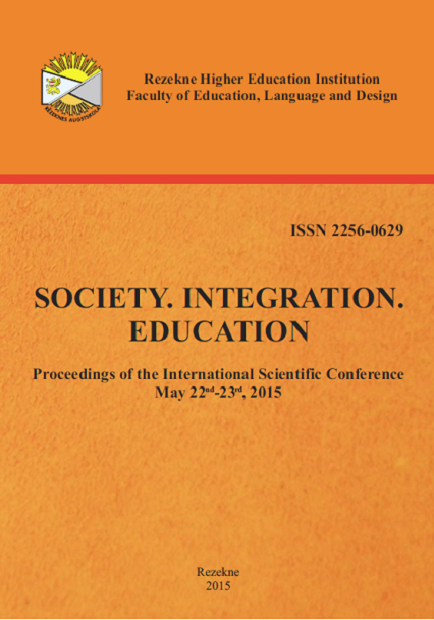The Affect of the Cranial Elektrotherapy on the Dynamic Parameters of Movements
DOI:
https://doi.org/10.17770/sie2015vol3.477Keywords:
CES, power, strength, velocityAbstract
It is considered that in sport athletes use the cranial electrotherapy stimulation (CES) to improve the performance and to increase the ability to concentrate before the competition. Based on the previous researches we can conclude that CES is absolutely safe. Therefore, the aim of the current study is to determine the CES affect on the dynamic parameters of movements (power, strength, velocity). Subjects of our study were twenty healthy athletes of luge, bobsled and skeleton. The evaluation of the dynamic parameters of movements was performed before and after CES during the barbell „lift„ in concentric phase of lifting with FiTRODyne Premium device (Slovakia). To analyze data was used Excel program Statistics 3.1.
After the CES the parameters of power capacity and the results of strength were improved (α < 0,05). The differences between the time parameters of the controlled exercise before and after CES were not statistically significant (α > 0,05 ), also the improvement of the velocity of controlled exercise is not statistically significant ( α > 0,05 ).
The results obtained in the research prove that the affect of 10 minutes of CES partly influence the dynamic parameters of movement.
References
Braverman, E., Smith, R., Smayda, R., Blum, K. (1990). Modification of P300 amplitude and other electrophysiological parameters of drug abuse by cranial electrical stimulation. Current Therapeutic Research, 48, 586-596.
Brotman, P. (1989). Low-intensity transcranial electrostimulation improves the efficacy of thermal biofeedback and quieting reflex training in the treatment of classical migraine headache. American Journal of Electromedicine, 6(5), 120-123.
Dravnieks, J. (2004). Matemātiskās statistikas metodes sporta zinātnē. Mācību grāmata LSPA studentiem, maģistrantiem, doktorantiem. Rīga: LSPA, 76 lpp.
Fernāte, A. (2002). Sporta treniņu teorijas pamati.[ 1.d.]. Latvijas Sporta pedagoģijas akadēmija. Rīga, 60-67.
Hefferman, M. (1996). The effect of a single cranial elektrotherapy stimulation on multiple stress measures. In: Eight Internationa Montreux Congress on Stress, Montreux Switzerland, p.60-64.
Gilula, M., Kirsch, D. (2004). Cranial electrotherapy stimulation review: a safer alternative to psychopharmaceuticals in the treatment of depression. Journal of Neurotherapy, 9(2), 7-26.
Gilula, M., Kirsch, D. (2005). Cranial electrotherapy stimulation review: a safer alternative to psychopharmaceuticals in the treatment of depression. Journal of Neurotherapy, 2(9), 63-77.
Kirsch, D. (2002). The science behind cranial electrotherapy stimulation. Medical Scope Publishing. 1-224. Retrieved from: http://theprovenremedy.com/Assets/statpdf/painmgmt_pracguide.pdf
Kirsch, D., Smith, R. (2004). Cranial electrotherapy stimulation for anxiety, depression, insomnia, cognitive dysfunction, and pain. Bioelectromagnetic medicine, 727-740.
Kirsch, D. (2008). CES for mild traumatic brain injury. Practical Pain Management, 8(6), 70-77.
Kirsch, D., Smith, R. (2004). Cranial electrotherapy stimulation for anxiety, depression, insomnia, cognitive disfunction and pain. Bioelectrical medicine, 727-740.
Komi, P. (1990). Strength and power in sport. Oxford: Blackwell Scientific Publikations.
Konrads, A. (2000). Spēka attīstīšana. LSPA.Rīga, lpp.80.
Krauksts, V. (2003). Biomotoro spēju treniņu teorija. Rīga: LSPA, 55-70.
Latash, M. (2008). Neurophysiological Basis of Movement. United States: Human Kinetics, p.255.
Mateo, M., Blasco-Lafarga, C., Martínez-Navarro, I., Guzmán, J.F., Zabala, M. (2011). Heart rate variability and pre-competitive anxiety in BMX discipline. Eur J Appl Physiol. Retrieved from: http://www.ncbi.nlm.nih.gov/pubmed/21503698
Molotanovs, A. (2013). Sacensību darbības optimizēšana handbola vārtsargiem (uz HK LSPA komandas piemēra). Promocijas darbs. Rīga, LSPA, 40-80.
Overcash, S., Siebenthall, A. (1989). The effects of cranial electrotherapy stimulation and multisensory cognitive therapy on the personality and anxiety levels of substance abuse patients. American Journal of Electromedicine, 2(6), 105-111.
Song, S., Wang, D. (2007). CES technology's effects on athletes' brain function. Journal of Wuhan Institute of Physical Education, 9(41), 40. Retrieved from:
http://en.cnki.com.cn/Article_en/CJFDTOTAL-WTXB200709013.htm
Viltasolo, G., Osterback, L., Alen, M. (1987). Mechanical jumping power in young athletes. ActaPhysiol.Scan, 1.
Дворкин, Л.С., Слободян, А.П. (2005). Тяжелая атлетика: учебн. для институтов физ.культ.М.: Советский спорт, 600с.
Ковалев, А.С. (2004). Эффективность транскраниальной электростимуляции в психофизиологическом сопровождении учебного процесса курсантов военного вуза. Автореф. дис. Военно-медицинская академия им. С.М. Кирова. Санкт-Петербург. C.143.
Милостной Ю.П. (2007). Особенности гемодинамики и эмоционального состояния у дзюдоистов после интенсивной нагрузки и их коррекция с использованием транскраниальной электростимуляции. Автореф. дис. Курск. C.115.
Троянов, Р. Н. (2003). Физиологические эффекты применения транскраниальной электростимуляции и биоуправления в коррекции вегетативного статуса спортсменов. Волгоградская государственная академия физической культуры. Волгоград. C.175.






